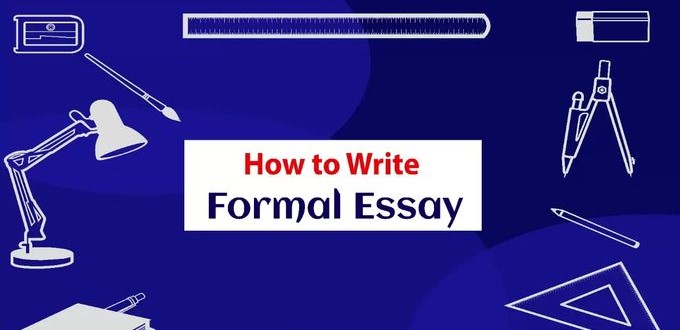How to Write a Formal Essay – Types, Format, Rules, Style And Structure
Publication Date: 30 December 2022
The formal essay is a widespread type of academic paper. At the first glance, it may seem that the name “formal” contradicts the very nature of essay as a genre, as a light, personal and flexible type of academic writing. Nevertheless, the formal essay retains the key features of the genre, such as structure, length, and composition, but at the same time is much more academic: it prohibits the use of a first-person narrative, jargon, clichés, deviation from a fixed structure, and excessive emotions.
In this article, you will learn:
- how to write a formal essay;
- what a formal essay format and style are;
- what is meant by a formal outline for essay;
- where to find a good formal essay example;
- and arm yourself with plenty of tips and easy-to-follow guidelines.

The Formal Essay Format and Style
There are no strict-written requirements for the format and style of a formal essay, though a number of general features and guidelines (borrowed from formal writing) apply.
The main features of the formal writing style are specific means of vocabulary and grammar, and special sentence constructions that turn the text into a dry and precise narrative, understandable to a narrow circle of specialists.
The formal style is characterized by thinking over the presentation in advance, and a clear and strict choice of means of linguistic expression. The formal writing style is distinguished by a preliminary consideration of the presentation, a strict selection of linguistic means, and the normalization of speech. The story in each formal essay example is a monologue. There is no dialogue with the reader.
The facts are explained clearly; cause-and-effect relationships and patterns are shown. The text flow in a formal essay is strictly logical. There is a clear semantic connection between the parts. The author’s statements are precise, concise, understandable, and unambiguous.
Conclusions follow from the contents of the main part; there are no contradictions in them. The whole main body’s text is divided into semantic parts according to the principle from particular to general and vice versa.
The main form of thinking of a scientist is a concept. All scientific definitions are given clearly and unambiguously, the terms reveal their content. A formal outline for essay is also required, though with less detail and text than in a regular degree thesis or a dissertation. In the formal essay format used among business professionals, scholars, and governmental officials, terms prevail. They occupy one-fifth of the total vocabulary in each decent formal essay example.
The terms are used in only one sense. Polysemantic words are used in a formal essay style in one meaning, rarely in two. Furthermore, in the formal essay we use abstract vocabulary – the formalistic language coincides with the conceptual and logical language, acting as more abstract.
Among the dominating grammatical features are generalization and abstraction. Nouns are more widely used, since concepts prevail over actions.
Formal Essay Writing Tips
We have scanned through every available formal essay example in our database and were able to extract several valuable writing tips worth following:
- When planning to write a formal essay, you should realize the purpose of academic writing in general, which is that you have to convince the person who has to read this essay that you have understood the topic well and have done some valuable research.
- Therefore, you should carefully read the topic of your formal essay, find keywords, and really think through the problem.
- Write a formal outline for essay, preferably with some evidence that will help reveal the topic of your work, and back up your key point(s).
- Concisely and accurately note down arguments and examples.
- Use strict and formal language for each part of your work, especially the conclusion, since according to the formal essay format, this one should be especially concise and down to the point.
- Always allocate no less than 20% of your overall writing time to the final editing and proofreading. When doing so, check against your initial formal outline for essay to see if you have included all the main points and ideas.

General Guidelines for Constructing a Formal Essay
The formal essay should begin with an introduction, which should highlight the general approach to the topic. The introduction should contain a problem and the task of the author in the essay. In the formal essay format, this is called the thesis or thesis statement of the essay.
The thesis statement clearly defines the boundaries of essay writing. The author of the formal essay does not have the right to describe everything that he knows within the scope of the given topic, but only what will be a creative answer to the question posed in the topic.
Throughout the formal essay, it is necessary to emphasize the connection of the presented facts with the thesis. Make sure you list those facts in your formal outline for essay first.
The main part of the formal essay is built to convince the reader. For this, the author of the formal essay must use strong arguments. First, it is worth setting out the main ideas and facts, which will later be confirmed by examples, research findings, and/or pure logic.
The volume of the formal essay should not be very large (although there are no clear guidelines and limitations regarding the volume of the formal essay). An average size of an average formal essay example that we have come across is 900 words or two-three pages of text in regular academic font size.
The Structure of a Formal Essay – Important Rules
- The formal essay format stipulates that the introductory part should be concise, but expressive and contain a central point – a thesis statement.
- The last sentence of the introduction and the first sentence of the main part should be organically connected. The essence of the connection: explanation of the validity of the thesis statement used earlier.
- The volume of the main part is not strictly regulated, but it must be remembered: as the volume of the essay increases, it loses the lightness of the genre. Even the longest formal essay example would rarely exceed 1500 words in volume.
- The main part is related to the conclusion not only by the thought but also by the way of language design (through the central image).
- The formal essay must contain a voiced ending. At the same time, it does not matter at all whether the end is an affirmation of anything, a question, or an incomplete reflection. The use of aphorisms and quotations is considered a good way to end an essay, even such a regulated one as a formal essay.
A Captivating Introduction
An introduction is a very important element of the work. Based on the intro, the readers will decide whether they should read your essay further or not. There are several approaches to starting an essay. We suggest you think them all through and aim to implement them in your formal outline for essay.
- Standard (the most common). Six questions must be answered: who, what, when, where, why, and how. The answers to these questions will give the reader an idea of what to expect.
- Unexpected – it can be anything, but the reader should be surprised or shocked.
- Active — the image of the process itself, and the causes and consequences that will follow. This approach is convenient for short or formal essays.
- Authoritarian – offers information in a commanding tone to create the impression that the author is confident and knowledgeable.
- Informative – the reader immediately receives information about what will happen next in the work. This one is very common and is implemented (at least partially) in every formal essay example.
- Quotable – a well-chosen quote immediately attracts the reader’s attention (it is not recommended to use proverbs and clichés – they are taboo in formal essay writing).
- Dialogic – on the one hand, such a beginning stimulates the reader as a participant in the dialogue, on the other hand, it can simply be a flow of thoughts with rhetorical questions.
References in a Formal Essay
Besides the third-person voice and strictly academic language, proper referencing is another distinctive feature of a formal essay. We would say that referencing is a must in this type of academic paper, and there is no single formal essay example we could see, which doesn’t contain at least several references.
The most frequent referencing styles used in a formal essay format are MLA and APA. Both are highly popular in the academic world and are best suited for humanities and social sciences.
When it comes to the number of references one should make in a formal essay, there are no strict prescriptions, although there is a clear correlation between the formal essay length and the number of references. An average academic norm is to have one reference per every 200 words of your formal essay body (excluding the introduction and conclusion). This is just a general recommendation, of course, while in real life many variables can affect that parameter. However, based on that correlation, you can do the math on your particular essay assignment.
For example, you have to write a 1000-word essay. Then, a recommended number of references would be 3 references. This is based on the assumption that for an average 1000-word essay, the main body would be about 700-750 words (with the remaining 1/3 allocated to the introduction and conclusion).
At the same time, it is far more important to make your references do their job! In a formal essay of such length, your instructor is expecting you to show a mature, thoughtful approach. Teachers expect you to critically analyze the works you are referencing (by the way, in a formal essay, those ideally should be peer-reviewed works).
By using someone else’s work, you are strengthening your formal essay ideas and making informed choices. It’s pointless having 10-12 references that do not connect to your story well. Instead, the 3-5 sources you cite that are peer-reviewed and which thoroughly back up and support your essay’s claims – such references make a huge positive difference. Planning proper referencing at the early stage of the formal outline for essay is critically important.
Frequently Asked Questions
How many paragraphs are there in a formal essay?
The formal essay format requires at least 3 paragraphs for the simplest (shortest) formal essays, and 3-5 paragraphs for the medium to long essays.
Can I use a second-person voice in my formal essay?
In a formal essay, only the third-person voice is allowed.
Where can I find a formal essay example?
The fastest route is to search online. However, if you want something tailored to your specific needs, we recommend registering with a professional writing service and accessing their sample databases.
Are abbreviations allowed in a formal essay?
No, abbreviations are not allowed in formal essays. Therefore, all words should be written in full without any contractions or shortened forms.
What is a formal outline for essay?
In a formal essay, outlining is an essentially important technique. Students are actively encouraged to make outlines before writing, so in your assignment, you may see a separate point asking you to make an outline and submit it along with your main text.





